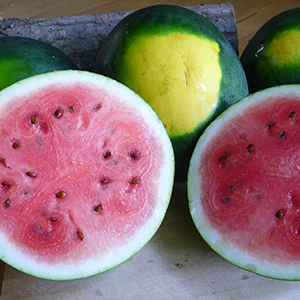
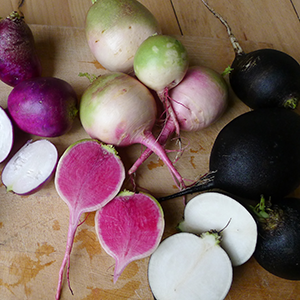
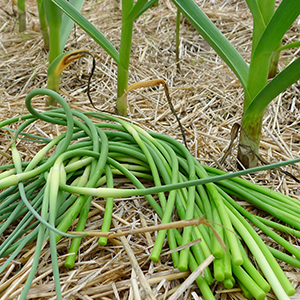

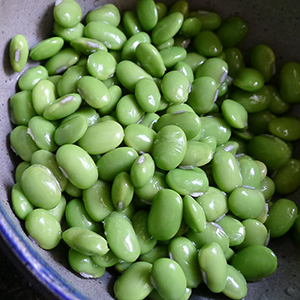
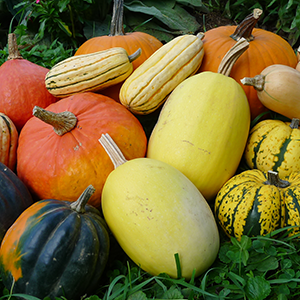
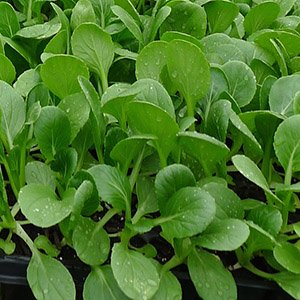



News and Notes | The Anchor Run Blog
Posts Filtered by Month - January 2018 |
Show Recent Posts
January 28, 2018
Super Foods for Your Super Bowl
By Derek McGeehan
Super Foods for Your Super Bowl
By Derek McGeehan
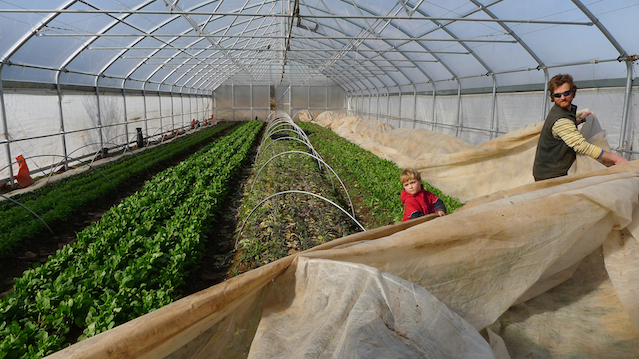
Getting some help uncovering greens in the movable high tunnel on another (beautiful) 60 degree January day.
Winter Harvest #6 (Week B) should include sweet potatoes, garlic, rosemary, lettuce mix, root choice #1 (celeriac, purple daikon, scarlet turnips), root choice #2 (carrots, beets), greens choice (baby kale, spinach), and cabbage (napa, red, green). After this week we will probably say goodbye to sweet potatoes, green cabbage, beets, and carrots but will welcome some new treats starting next week.
Create the most amazing snack for the Super Bowl by slicing your roots into crudités for a healthy hors d'oeuvre! Great raw veggie options include kohlrabi, daikon radish, carrots, and turnips).

January 28, 2018
Winter Days
By Derek McGeehan
Winter Days
By Derek McGeehan
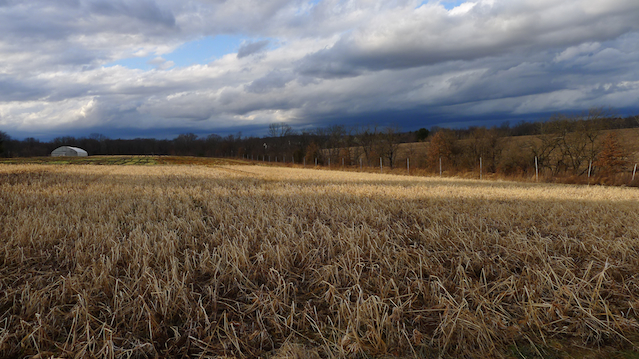
Winter farm scene at Anchor Run.
We're still enjoying fairly mild weather for the middle of winter. February arrives this week as we eclipse the 10-hours-of-daylight mark. We're also halfway through the Winter CSA and now daylight is going to increase rapidly as we move towards the spring equinox. During these mild winter days we walk around the farm while brainstorming ways to improve the farm for the upcoming growing season as well as farther into the future. Annual produce crops will give us immediate enjoyment this year but perennial crops like asparagus, raspberries, fruit trees, and blueberries will take a few years until they bear fruit. As we fine-tune our crop plan and rotation we realize that due to better yields and improved decision making our growing footprint is actually shrinking, allowing us to use new available land for long-term crops like the ones previously mentioned, or a sustained cover crop fallow period for soil improvement.
Thus, new challenges beckon. Sweet fruits are definite crowd pleasers and we're striving to figure out ways to bring these additional crops to you. As a Certified Organic farm there's probably a bit of a challenge in growing chemical free and healthy fruit which is why you don't see any organic fruit and berries around. We're excited to try. We're hopeful that in the same way we're able to successfully grow high quality organic produce we can slowly add more berries and tree fruits to the mix. There will be some trial by error for sure, and unfortunately the longer term investment might not reveal the errors quickly, but that's what it will take to get it right. We still have a lot to learn, but over the past 3 years we've planted 65 fruit trees, 200 blackberries, and 500 raspberries. This upcoming season we're planting 500 more raspberries and 150 blueberries as well as expanding our strawberry patch. We think diversification is key to a healthy and successful farm. Thank you for your support.
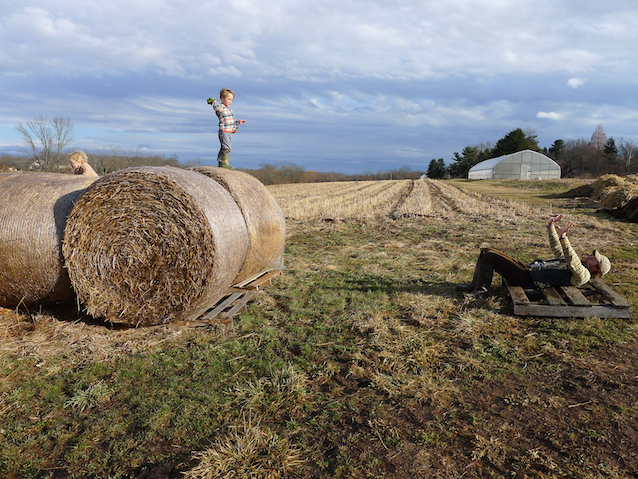
Claytonia (aka miner's lettuce or winter purslane) toss on a warm winter day. Abigail doesn't eat much raw produce just yet, but she does enjoy munching on heads of claytonia, which should arrive in shares in week #7. The heads in the shares won't be munched on.

January 28, 2018
One Pot Meals...continued
By Linda Dansbury
One Pot Meals...continued
By Linda Dansbury

Sampling claytonia, harvested from the greenhouse. Abigail describes the flavor as subtle, a balance of bitter and sweet, with a juicy texture.
With all the illness going around right now - my hubby included - I wanted to make something easy, delicious, warming and healing. Chicken soup is my usual go-to, but I wanted something a little different and simpler since when I make chicken soup it always starts by making my own broth.
I found a recipe for Star Anise-Ginger Braised Whole Chicken. It was so easy to pull together. You do need a bit of time, as it takes 1 and a half hours, but only 15 minutes is active time. The recipe calls for celery as part of the veggies, but I used celeriac and daikon instead. Celeriac adds a flavor profile very similar to celery since they are in the same family. The recipe on-line says to servce with crusty bread, but I made brown rice since in China, braised chicken in stock is always served with rice. I love using star anise in recipes because it makes the house smell so delicious!
I hope you're enjoying the harvest - I sure am!!

January 21, 2018
One Pot Meals
By Linda Dansbury
One Pot Meals
By Linda Dansbury

An eastern redcedar/juniper was an unfortunate casualty from a felled dying ash tree but it at least provided a glimpse of its beautiful red heartwood and growth rings.
Everyone is rushed these days, and who wants to spend a lot of time in the kitchen doing dishes? Here are a few ideas for delicious dinners with easy clean up:
If you don't already have a slow cooker, it really is a worthwhile investment. It is a fine tool in both the winter and the summer - in the summer it is a great way to cook without heating up the house and it also saves a lot of time in doing dishes! If you are able to, purchase a pressure cooker that is also a slow cooker. I received one for Christmas a couple of years ago, and I love it. It sears, pressure cooks, slow cooks and even makes deserts and rice. And...it is one pot clean up! This week, I slow cooked pulled pork - so simple and delicious!
Cabbage, spinach, celeriac - I made a large batch of cole slaw to go with the pulled pork - many of the root veggies we are receiving are delicious in cole slaw - kohlrabi, celeriac, turnips, daikon - I added a little spinach for a dark green contrast and a nutritional boost. Use your favorite recipe - I typically use equal parts of neutral oil, white wine or apple cider vinegar and mayo. Add a bit of cayenne, dried mustard, salt and pepper to taste - whisk it up, mix with the veggies and let sit in fridge for taste to go through. This keeps for several days.
Beets, sweet potatoes, onions, potatoes, kohlrabi, turnips, daikon, rosemary, garlic - to continue on my one pot plan, in a large baking dish, cut up all the veggies you want to include - add much more than you can eat in one meal. Toss with some olive oil, salt and pepper and rosemary leaves. Put some type of meat on the top and roast all in a 375 degree oven until the meat is a desired doneness. If you use a small cut of meat such as chicken parts, roast the veggies for a little while on their own so they will be nice and tender when the meat is cooked through.
I like to use the leftover roasted veggies in a frittata - heat up the veggies in a skillet - I had a few leaves of kale, so I chopped those and added - then add eggs, allow to set on bottom for a couple minutes and then put in a 375 degree oven until the entire pan of eggs is set up - it depends how much you are making, but approximately 15-20 minutes for 8 eggs.
I also reaped some of the rewards of cooking back in September - I had made a batch of minestrone soup with the last of several veggies - beans, okra, tomatoes and greens and labeled and froze. This past week I thawed it out, browned some sausage and added to the soup, along with pasta and some fresh spinach. Topped with grated cheese - yum - a really satisfying winter dinner with very little clean up.
Enjoy the harvest!

January 21, 2018
Celeriac, Celery Root, Knob Celery Arrives
By Derek McGeehan
Celeriac, Celery Root, Knob Celery Arrives
By Derek McGeehan
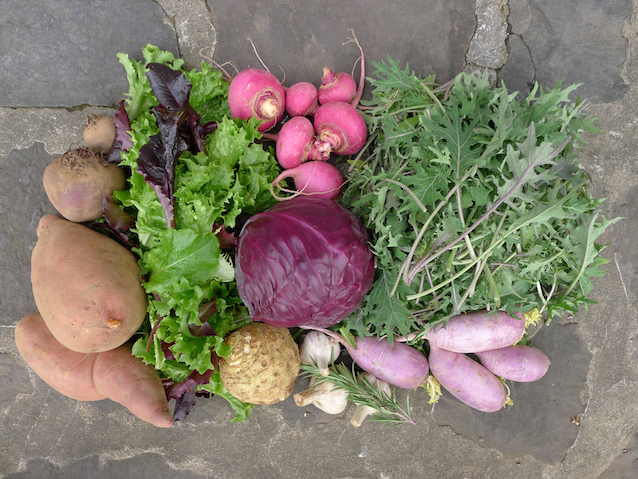
Winter Harvest #5 (Week A) should include sweet potatoes, garlic, rosemary, lettuce mix, cabbage (red, green, napa), root choice #1 (daikon, scarlet turnips, kohlrabi), root choice #2 (beets, celeriac) and greens (baby kale, spinach, greens mix).

January 21, 2018
Another Thaw as Solar Winter Nears End
By Derek McGeehan
Another Thaw as Solar Winter Nears End
By Derek McGeehan
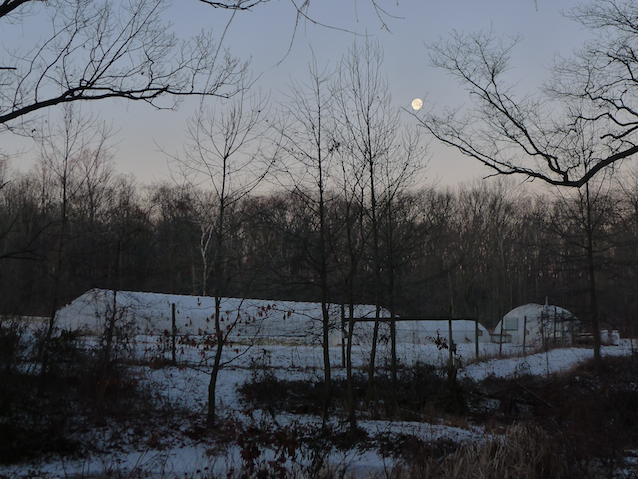
Cold winter morning with a descending super moon from a month ago.
I guess I'm still reeling from the 2+ weeks of extremely frigid weather because now when I look at the 10-day forecast and 5 of those days are supposed to be 50 degrees or above a part of me feels incredulous, a sense of disbelief. We're not even quite halfway through astronomical winter but that kind of forecast is more like March than January. That said, we're pretty close to rapidly increasing daylight and are 10 days away from 10 hours of daylight. We're also about out of our hemisphere's solar winter, the quarter of the year with the least amount of daylight. Because of the heat lag though we still have cold weather ahead (probably). I did read that by mid-February temperatures are supposed to be average or slightly below, which still sounds warm to me after the cold we've already experienced.
While it's warm for the next few days we'll remove the inner covers from our tunnels and open doors so air can circulate better. On warm days this time of year air exchange in the tunnels is important to quell the spread of any disease. This will also give us a chance to assess all of the greens and plan for the next few weeks of harvest, as well as get an idea of any sustained damage from the previous cold spell.
We've made great progress on our 2018 Crop Plan and are beginning to put the pieces of the crop rotation puzzle together for this season. Bed feet was calculated for each crop/family, 2015-2017 use is taken into account, cover crop species sown in summer/fall 2017 are considered, soil test results are analyzed, drainage is appreciated, and thus plans are made, 2018 farmscape takes form.

At least it's not too cold to play outside.

January 21, 2018
Turnip Idea
by Dana Hunting
Turnip Idea
by Dana Hunting
From Luke Smithson, longtime CSA member and Executive Chef at Jamie Hollander Catering & Events:
I took a mix of the red and white turnips, cut them into bite size chunks then dropped them into salted boiling water for about 5 minutes, until tender. Drained, then back into the pot with a nice chunk of butter and a generous drizzle of maple syrup for another 5 minutes until well caramelized. Finished with salt. Awesome!

January 14, 2018
Something New
By Derek McGeehan
Something New
By Derek McGeehan
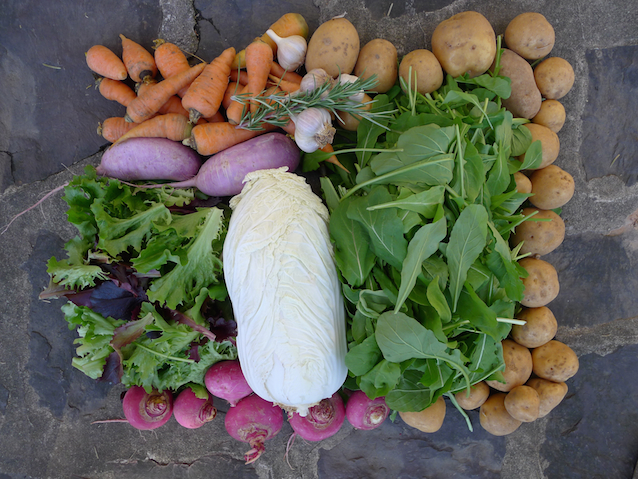
Winter Harvest #4 (Week B) should include potatoes, carrots, garlic, rosemary, lettuce mix, cabbage (red, green, napa), roots (kohlrabi, daikon, hakurei turnip, scarlet queen turnip), and greens (spinach, arugula, baby kale).
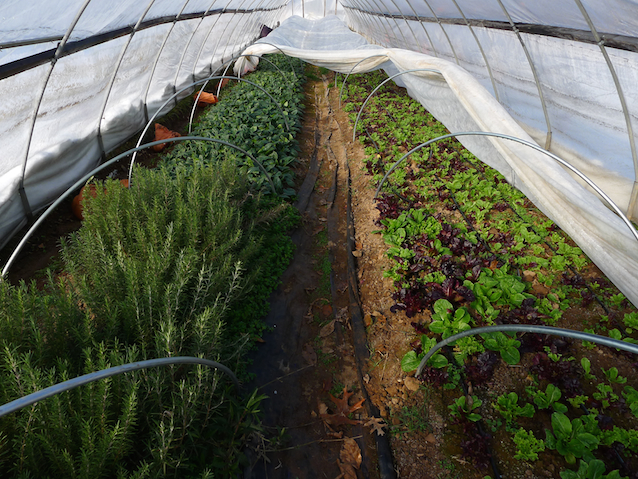
New in upcoming shares: rosemary (on the left). We didn't think we could harvest it during the winter; turns out we can. Our original goal was to simply overwinter it successfully.

January 14, 2018
Waterlogged and Productive Thaw
By Derek McGeehan
Waterlogged and Productive Thaw
By Derek McGeehan
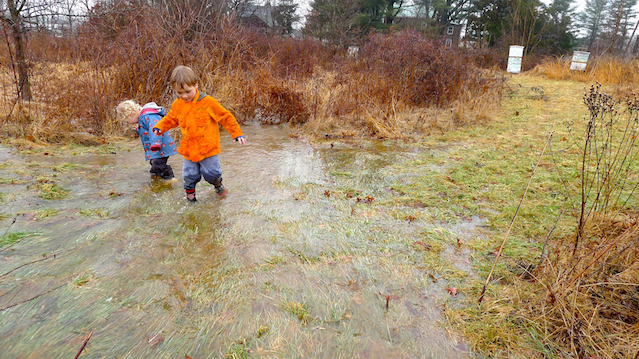
We welcomed above freezing temperatures and mud back to the farm this past week. The warmer temperatures allowed us to spend more time outside, continuing farm/barn clean up, tree trimming, ditch clearing, water stomping. For farmers' sanity, even during winter months when indoor time is needed for administrative purposes, some time each day must be spent outside, and it's much more pleasant (obviously) when it's 40, 45, 50, 65 degrees. And some good news: most of the crops survived the extensive deep freeze intact. Some of them, like the baby kale, required approximately 5 days of warmer weather before they fully perked up.
The torrent of water on Friday reminded us of areas of the farm that have water issues and need some improvement. Water management is an ongoing project, one that we're hoping Natural Resources Conservation Service (part of USDA) will provide some help with. In the past they've assisted with the establishment of a 2.5-acre pollinator habitat and a grant for some of the cost of the movable high tunnel.
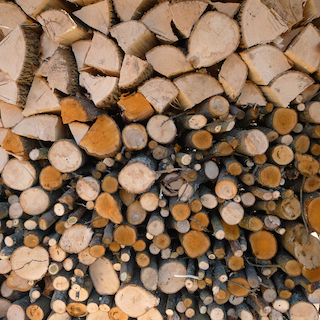
Some administrative tasks we've been working on the past few weeks, and continue to work on, include: updating the crop plan and evaluating every crop we grow which involves adjusting quantities of plants, dates for seeding and transplanting, and altering growing methods. For example, basil will be divided into 5 smaller plantings; winter squash, husk cherries, and tomatillos will be grown in 12-foot wide fabric ground cover to suppress weeds, disease, and make harvesting easier; the 2nd planting of tomatoes will be grown under protection in the new hoop tunnel; the heirloom tomatoes will be grafted on rootstock; the cantaloupe crop is doubling is size; brussels sprouts and sweet corn are being added; fall kohlrabi is being reduced. Subsequently, linear bed feet will need to be calculated for each crop so we can update our crop rotation and have a planned location for each one. It's a vision for the future and a fun puzzle to put together.
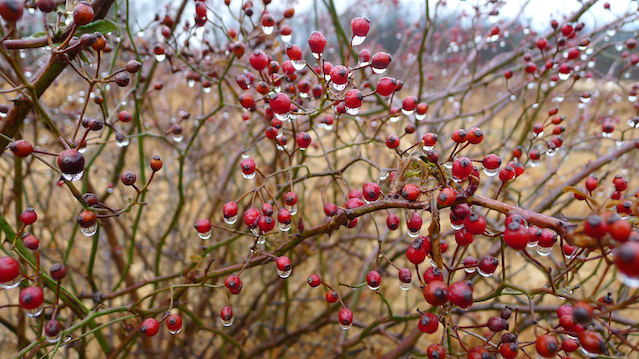
Multiflora rose is an invasive species, but its seeds/berries are winter food for birds.

January 7, 2018
Through Our Deepest Freeze
By Derek McGeehan
Through Our Deepest Freeze
By Derek McGeehan
Winter Harvest #3 (Week A) should include potatoes, garlic, lettuce mix, carrots, greens choice (arugula, baby kale, spinach), cabbage choice (napa, green, red), and a root choice (kohlrabi, purple daikon radish, hakurei turnips, scarlet queen turnips).
**We're still thawing out after the deep freeze and the greens are only just beginning to show their tolerance so we're not exactly 100% sure what greens will be in the share besides lettuce mix**
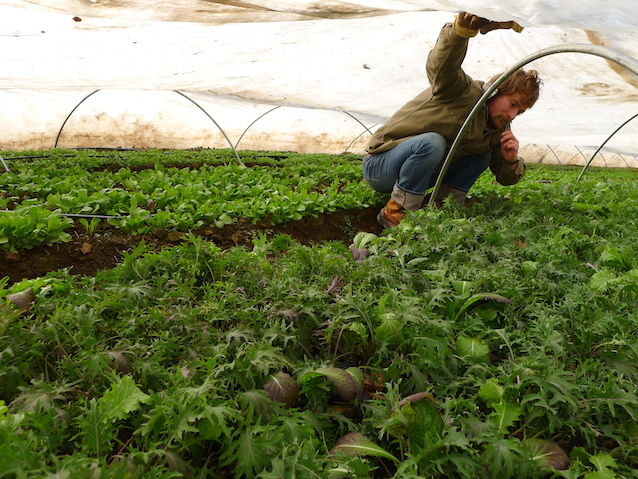
Checking on the greens underneath two layers of interior row cover in the high tunnel. Amazingly, as of Sunday afternoon, much of them look like they should be harvestable this week and beyond. The taste is also truly incredible thanks to the cold; I'm pretty sure that was the sweetest kale I've ever eaten.

January 7, 2018
All is Not Lost
By Derek McGeehan
All is Not Lost
By Derek McGeehan
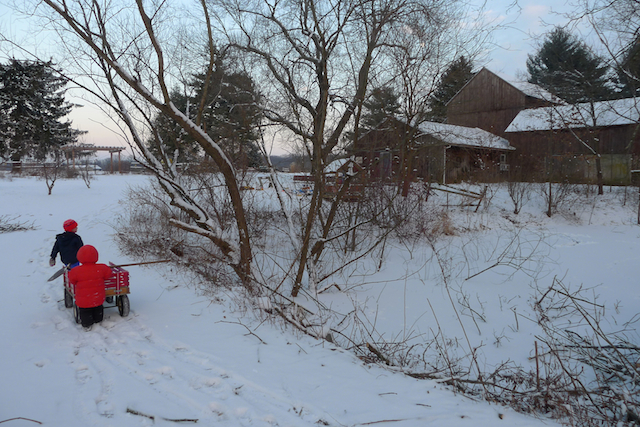
Heading home after some serious snow play.
Our fingers and toes are still crossed (maybe frostbitten) as we continue to positively hope for successfully getting through this unforeseen deep freeze. Now, at least, 5 degrees without wind doesn't feel all that cold; when it's sunny and 15 degrees it feels warm. At least we have some snow to play in, too.
We are looking forward to trying to wash in the barn this week when it will be 40 degrees instead of 15-20 like last week. The washing experiment taught us that when it is that chilly, water freezes quickly to the conveyor chain on our root washer rendering it unusable. Hannah then bravely sprayed off the roots as much as possible while laying them out on bread trays. It had to be done very quickly before any of them froze.
It appears that a January thaw is in store for us this week and quite unbelievably it may be in the 50s next weekend. Crazy?
One important issue that we somehow (?) overlooked while we were more focused on successfully growing and storing winter crops is how to appropriately heat the barn in the future, warranting some serious consideration for a system that can heat the entire lower floor. We've managed to make the pick up room somewhat comfortable/tolerable using greenhouse plastic, tarps, old row cover, and space heaters, but this doesn't feel like a permanent solution to us, even though it is contemporary-rustic-farm-chic.
Thanks for growing with us!
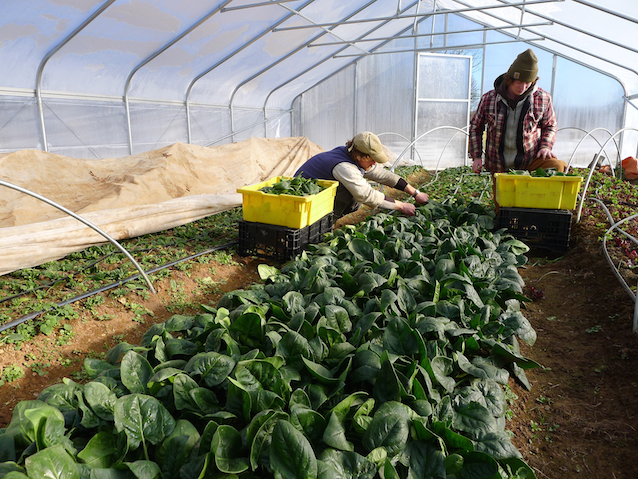
Harvesting cold tolerant spinach with Pat from the new hoop tunnel last week for share #2.

January 7, 2018
Healing Soup and Warming Stew
By Linda Dansbury
Healing Soup and Warming Stew
By Linda Dansbury

Farm animals Sugar Snap and Borchie warming by the fire. Barn cats Monday and Grrrl Cat have been brought into warmer climes as well and have settled into a hibernation-like state.
Record breaking temperatures, and yet we are still going to receive delicious greens this week and beyond. I am so happy that D&D decided to take this challenge on, starting a few years ago. Thank you for the amazing produce!
Onions, carrots, kale, garlic and local chicken - This week a family member came down with a cold, so I quickly cooked up chicken soup - studies show that it isn't just an old wive's tale that chicken soup helps heal the body. Since I still had kale from a couple weeks ago, I added kale in at the end to add additional nutrients to the pot - yum!
Onions, carrots, sweet potatoes, potatoes, daikon radish, kohlrabi, turnip, celeriac, garlic, kale and local beef - this cold weather had us craving comfort foods - rich, warm, yummy stew is what did the trick. I had both stewing meat and short ribs so first I browned the meat and removed from pot. Added onions and carrots to pot and got them going for a bit. When they were starting to get a bit soft, added garlic and after a minute sprinkled in a couple tablespoons of flour and mixed it all up with the veggies and kept the mixture moving in the pot (doing this "cooks" the flour so it will thicken the stew but not give it a raw flour taste). Next I added about half a bottle of red wine and de-glazed the pot. Added some tomato paste and tomatoes that had been frozen during the summer. Added beef stock, added meat back in and let that simmer for about an hour. Meanwhile, I chopped up all the other veggies and added them to the pot and simmered it all for about another hour and a half. It was delicious and made enough for a few meals.
Sweet potatoes, potatoes, celeriac - made "mixed mash" - cut everything up - I don't even peel the potatoes or sweet potatoes - boiled until all were tender and then mashed as normal. Depending on what it is going with, garlic and/or thyme/rosemary can be added to the pot too.

POSTS BY TYPE
POSTS BY MONTH

